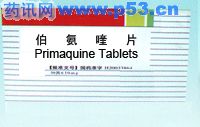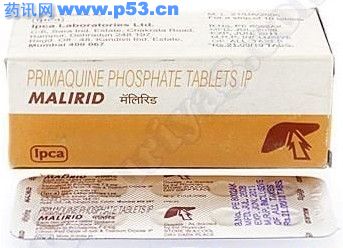|
英文药名: Primaquine tablets 中文药名: 伯氨喹片 药物名称 药物名称: 伯氨喹 功用作用 现主要用于根治间日疟和控制疟疾传播,常与氯喹或乙胺嘧啶合用。对红内期作用较弱,对恶性疟红内期则完全无效,不能作为控制症状的药物应用。对某些疟原虫的红前期也有影响,但因需用剂量较大,已接近极量,不够安全,故也不能作为病因预防药应用。 用法用量 注意事项 Primaquine Tablets,7.5mg Product Name: Primaquine Tablets.
Strength: 7.5mg. Packing: 10tablets/blister,10blisters/box,or 1000tablets/tin. Port: Any port (depends on requests) Certificate: GMP. Exporting Region: Areas which GMP is applicable. OEM order is welcome! Primaquine Description Primaquine phosphate is 8-[(4-Amino-1-methylbutyl)amino]-6-methoxyquinoline phosphate, a synthetic compound with potent antimalarial activity. Each tablet contains 26.3 mg of Primaquine phosphate (equivalent to 15 mg of Primaquine base). The dosage is customarily expressed in terms of the base.
Inactive Ingredients: Carnauba Wax, Hydroxypropyl Methylcellulose, Lactose, Magnesium Stearate, Microcrystalline Cellulose, Polyethylene Glycol 400, Polysorbate 80, Pregelatinized Starch, Red Ferric Oxide , Talc, Titanium Dioxide.
Primaquine - Clinical Pharmacology
Primaquine phosphate is an 8-amino-quinoline compound which eliminates tissue (exoerythrocytic) infection. Thereby, it prevents the development of the blood (erythrocytic) forms of the parasite which are responsible for relapses in vivax malaria. Primaquine phosphate is also active against gametocytes of Plasmodium falciparum.
Indications and Usage for Primaquine
Primaquine phosphate is indicated for the radical cure (prevention of relapse) of vivax malaria.
Contraindications
Primaquine phosphate is contraindicated in acutely ill patients suffering from systemic disease manifested by tendency to granulocytopenia, such as rheumatoid arthritis and lupus erythematosus. The drug is also contraindicated in patients receiving concurrently other potentially hemolytic drugs or depressants of myeloid elements of the bone marrow.
Because quinacrine hydrochloride appears to potentiate the toxicity of antimalarial compounds which are structurally related to Primaquine, the use of quinacrine in patients receiving Primaquine is contraindicated. Similarly, Primaquine should not be administered to patients who have received quinacrine recently, as toxicity is increased.
Warnings
Discontinue the use of Primaquine phosphate promptly if signs suggestive of hemolytic anemia occur (darkening of the urine, marked fall of hemoglobin or erythrocytic count).
Hemolytic reactions (moderate to severe) may occur in individuals with glucose-6-phosphate dehydrogenase (G-6-PD) deficiency and in individuals with a family or personal history of favism. Areas of high prevalence of G-6-PD deficiency are Africa, Southern Europe, Mediterranean region, Middle East, South-East Asia, and Oceania. People from these regions have a greater tendency to develop hemolytic anemia (due to a congenital deficiency of erythrocytic glucose-6-phosphate dehydrogenase) while receiving Primaquine and related drugs.
Usage in Pregnancy
Safe usage of this preparation in pregnancy has not been established. Therefore, use of it during pregnancy should be avoided except when in the judgment of the physician the benefit outweighs the possible hazard.
Precautions
Since anemia, methemoglobinemia, and leukopenia have been observed following administration of large doses of Primaquine, the adult dosage of 1 tablet (= 15 mg base) daily for fourteen days should not be exceeded. It is also advisable to make routine blood examinations (particularly blood cell counts and hemoglobin determinations) during therapy.
If Primaquine phosphate is prescribed for (1) an individual who has shown a previous idiosyncrasy to Primaquine phosphate (as manifested by hemolytic anemia, methemoglobinemia, or leukopenia), (2) an individual with a family or personal history of favism, or (3) an individual with erythrocytic glucose-6-phosphate dehydrogenase (G-6-PD) deficiency or nicotinamide adenine dinucleotide (NADH) methemoglobin reductase deficiency, the person should be observed closely for tolerance. The drug should be discontinued immediately if marked darkening of the urine or sudden decrease in hemoglobin concentration or leukocyte count occurs.
Geriatric Use
Clinical studies of Primaquine did not include sufficient numbers of subjects aged 65 and over to determine whether they respond differently from younger subjects. Other reported clinical experience has not identified differences in responses between the elderly and younger patients. In general, dose selection for an elderly patient should be cautious, usually starting at the low end of the dosing range, reflecting the greater frequency of decreased hepatic, renal, or cardiac function, and of concomitant disease or other drug therapy.
Adverse Reactions
Gastrointestinal: nausea, vomiting, epigastric distress, and abdominal cramps.
Hematologic: leukopenia, hemolytic anemia in glucose-6-phosphate dehydrogenase (G-6-PD) deficient individuals, and methemoglobinemia in nicotinamide adenine dinucleotide (NADH) methemoglobin reductase deficient individuals.
Overdosage
Symptoms of overdosage of Primaquine phosphate are similar to those seen after overdosage of pamaquine. They include abdominal cramps, vomiting, burning epigastric distress, central nervous system and cardiovascular disturbances, cyanosis, methemoglobinemia, moderate leukocytosis or leukopenia, and anemia. The most striking symptoms are granulocytopenia and acute hemolytic anemia in sensitive persons. Acute hemolysis occurs, but patients recover completely if the dosage is discontinued.
Primaquine Dosage and Administration
Primaquine phosphate is recommended only for the radical cure of vivax malaria, the prevention of relapse in vivax malaria, or following the termination of chloroquine phosphate suppressive therapy in an area where vivax malaria is endemic. Patients suffering from an attack of vivax malaria or having parasitized red blood cells should receive a course of chloroquine phosphate, which quickly destroys the erythrocytic parasites and terminates the paroxysm. Primaquine phosphate should be administered concurrently in order to eradicate the exoerythrocytic parasites in a dosage of 1 tablet (equivalent to 15 mg base) daily for 14 days.
How is Primaquine Supplied
Primaquine phosphate is supplied in tablets of 26.3 mg (= 15 mg base), bottles of 100. (NDC 0024-1596-01)
Store at 25° C (77° F); excursions permitted to 15° – 30° C (59° – 86° F) [see USP Controlled Room Temperature]
Clinical Studies
Malariologists agree that malaria produced by Plasmodium vivax is the most difficult form to treat. This is ascribed to the ability of the parasite to develop extremely resistant tissue forms which are not eradicated by ordinary antimalarial compounds.
Thus, persons with acute attacks of vivax malaria, provoked by the release of erythrocytic forms of the parasite, respond readily to therapy, particularly to Chloroquine phosphate. However, prior to the discovery of Primaquine phosphate, no antimalarial drug was available that could be relied on to eliminate tissue (exoerythrocytic) infection and to prevent relapses. The various investigations made with Primaquine in experimentally induced vivax malaria in human volunteers and in persons with naturally occurring infections have demonstrated that the drug is a valuable adjunct to conventional therapy in this refractory form of the disease.
该药我们针对外国的客户可以大批量订购,并提供用于出口各国的认证 「有効成分」. プリマキン(Primaquine ).. 「同一成分含有商品」. マリリド(プリマキン)7.5mg (100錠) 「製造国」. インド... 成人:1日15mgを抗シゾント薬による治療後、14日間連続して経口服用します。 【使用における注意事項】 ・マリリド7.5mgはコップ一杯の水と一緒にのみ込んでください。 . ・胃腸の不快感を軽減するためには食中/食後の服用をお勧めします。 . ・毎日同じ時間帯に服用するようにしてください。 . ・医師の指示なしに服用を中断することはしないでください。 . ・例え同じ症状であっても、他者へ与えないで下さい。 . ・小さな子供の手の届かない冷暗所(25度以下)で保存してください。 ... 「商品詳細」 . . マラリアは、年間3億-5億人が感染し、150万-270万人の死者があるとされている、熱帯から亜熱帯に広く分布する原虫感染症です。 マラリア原虫は、ハマダラカと言う名前の蚊を宿主として有性生殖によって増殖し、ハマダラカの唾液腺に集まります。 マリリド7.5mgの有効成分であるリン酸プリマキンは、アミノキノリン化合物であり、マラリアにおいて特効薬とされているリン酸クロロキンと同様、赤血球内で増殖している三日熱マラリア原虫や卵型マラリア原虫の活力源を作り出す機能を阻害し、殺滅します。 「他の商品との比較」 .. 日本では未承認ですが、海外ではサノフィサンテラボ社によってPrimaquine Phosphateとして販売されています。 .. . 最近、パプアニューギニアや東部インドネシアなどでの感染例の中に、プリマキン耐性をもったマラリアの報告があります。 以下に該当する方のマリリド7.5mgの使用は禁忌とされています。 以下に該当する方へはマリリド7.5mgの使用は慎重に行う必要があります。 「他の薬との併用」 . .他の薬(大衆薬含む)と併用する場合には事前に医師または薬剤師に相談し、安全性を確認してから使用するようにしてください。 「誤って大量に服用した場合」 .. 「服用し忘れた場合」 .. 「副作用」 .. 主な副作用 稀に起こる重篤な副作用 “有效成分”。 伯氨喹(伯氨喹)。。 “产品含有相同的成分。” Marirido(伯)7.5mg(100粒) “的国家。制造” 印度。 。。 成人:1 15mg的太阳后,抗裂殖处理,然后连续14天口服。 关于使用[注意事项; *请用清水在玻璃7.5mg Marirido能美込ñ。 。 •以减少饮食/餐推荐剂量肠胃不适。 。 *请在同一时间采取的每一天。 。 - 停止服用没有医生的指导,请不要。 。 例如 - 即使是相同的症状,请不要给别人。 。 - 凉,儿童接触不到的小(低于25度)黑暗的地方去,请保存。 。。 。 “产品详细资料”。。 疟疾感染3.0亿-5亿人,有150万-270万人死亡,原生动物感染广泛分布在热带和亚热带。 疟疾寄生虫,对有性繁殖扩散作为主机名称叫按蚊蚊,按蚊唾液腺聚集。 Marirido的活性成分是氨基喹啉伯氨喹磷酸盐7.5mg化合物,氯喹磷酸盐以及作为银子弹疟疾红血细胞,间日疟原虫的疟疾寄生虫,和椭圆形的成长抑制能力生产能源,杀害。 “与其他产品相比”。。 它不是通过在日本,海外的公司在销售时,伯氨喹磷酸盐Sanofisanterabo。 。。。 “特别关注”。。 近日,一些诸如巴布亚新几内亚和印尼东部,以疟疾感染性,有报道伯氨喹。 Marirido以下,为7.5mg适当使用禁忌。 下面,并酌情向7.5mg Marirido必须小心使用。 “在与其他药物结合”。。 “如果你不小心过量”。。 “如果你忘记带”。。 “副作用”。。 主要的副作用 偶尔严重的副作用 |
|
当前位置:药品说明书与价格首页 >> 综合药讯 >> 伯氨喹片(Primaquine tablets)
伯氨喹片(Primaquine tablets)简介:
英文药名: Primaquine tablets
中文药名: 伯氨喹片
药物名称
药物名称: 伯氨喹 药物别名: 伯喹,伯氨喹啉 英文名称: Primaquine 药物介绍
功用作用 本品与扑疟喹同属8-氨基喹啉类衍生物,对红外期与 ... 责任编辑:admin |
最新文章更多推荐文章更多热点文章更多
|



